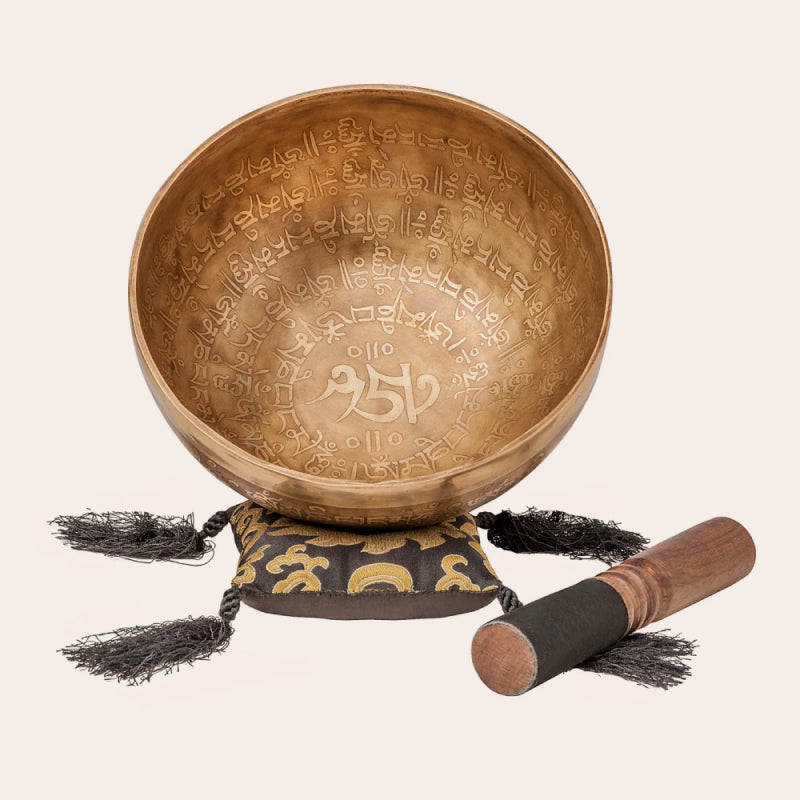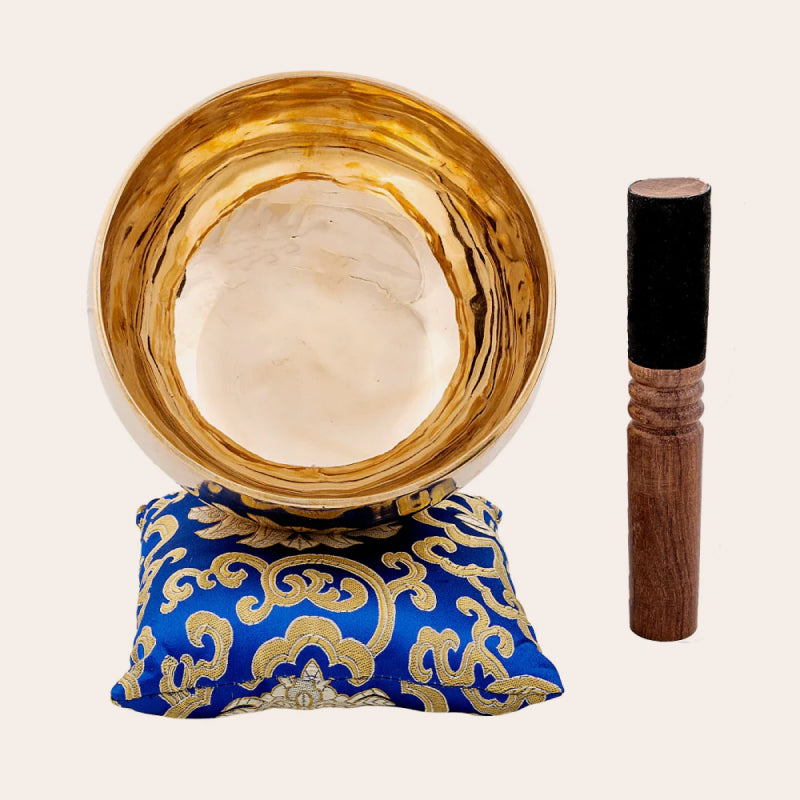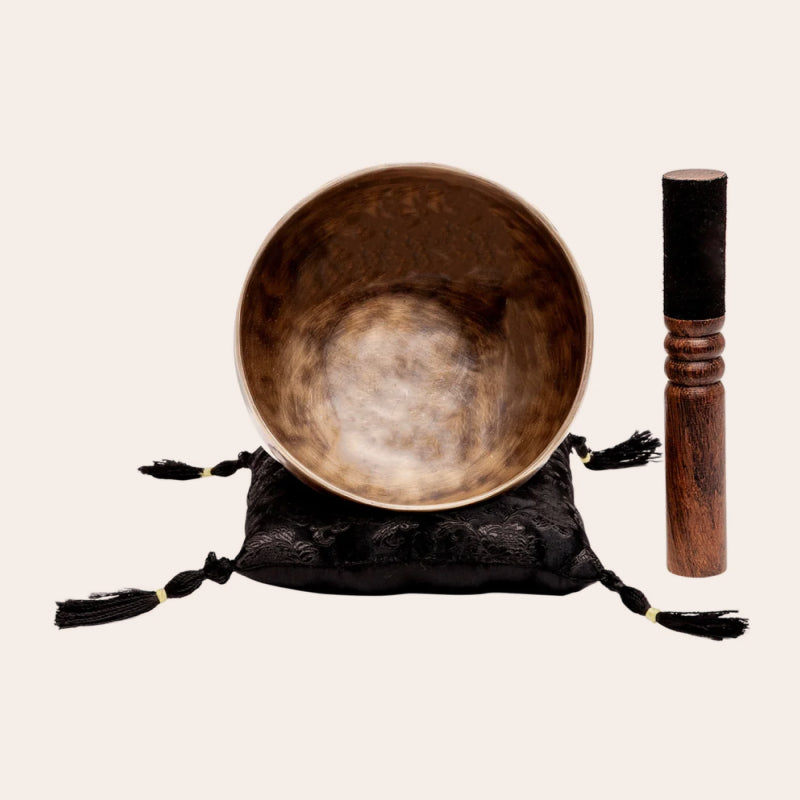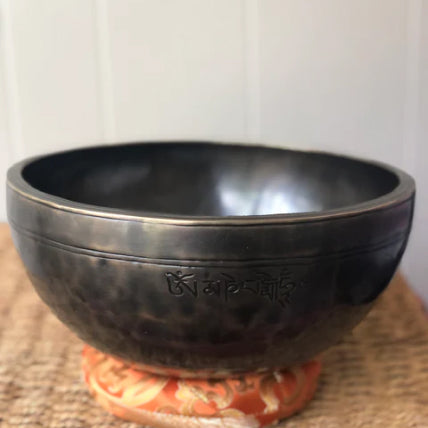Guide: Tones and Frequencies of Singing Bowls -What, Why, and How?
When you strike the rim of a singing bowl with a mallet, it makes a sonorous sound. At their core, singing bowls are powerfully simple instruments.
So, how do singing bowls create such calming frequencies? What are the tones of singing bowls? What are its frequencies?
A singing bowl reduces your heartbeat, improves focus, and even uplifts the mind to higher consciousness. How? It does so by emitting sound waves using friction and vibration. But different bowls have different frequencies and tones based on their sizes, shapes, composition, density, and surroundings.
Learning about the technical sound of singing bowls is perfect for understanding how the tones and frequencies of the bowl translate into healing vibrations.
Ready? Let's look at all that and more today!
What's So Special About Singing Bowl Sound? How Does It Make Sound?
The silver lining of sound bowls is their sounds can guide our brains into alpha, theta, and delta states of relaxation and meditation quickly. Almost exactly like when you're meditating. We described all about it in our five-part series of articles on How Sound Impacts the Body.
We need to find out how singing bowls make healing sounds and vibrations.
The friction of the mallet and its vibration on the metal or crystal body of a bowl creates sound vibrations. Hence, singing bowls aren't just any instruments but idiophones (an instrument that makes sound mainly with physical vibrations from itself).
So, a singing bowl sings because of vibrations you create using friction on its body by rubbing the mallet. Hence, not only do we hear these sounds, but we also feel their vibrations!
Do You Know About Singing Bowl Frequencies?
Everything in the universe is in a constant state of vibration. For instance, from the organs in our body to the vase on your table, each thing has a natural set frequency. And that includes singing bowls.
Frequency is nothing but the total cycles of vibrations per second. Moreover, singing bowls can generate sounds of several frequencies.
But, how do you detect or measure these frequencies?
How To Measure The Frequency Of A Singing Bowl?
The rule of thumb for finding the frequency of your singing bowl is by measuring its vibrations as you play.
However, singing bowl frequencies are anything but constant or accurate, thanks to their complex nature. They also switch in and out of varied tones because of the following factors.
The frequency of a Tibetan bowl changes based on the friction area. Plus, the frequency of the exact singing bowl can change based on where you strike it.
For example, striking the highest point of the sides creates a different sound, unlike tapping on the rim of the bowl.
The second cause of varying frequencies of a singing bowl is due to the craftsmanship of the bowl.
These are- the materials used for making it (metals, alloys, crystals), the size of its mouth, total density, the thickness of its walls, diameter, etc.
For instance, a bowl with a large diameter will have a deep pitch, but a thicker bowl will render a higher pitch. On the flip side, a low-frequency bowl will always make slow vibrations, and one with a high frequency will vibrate faster.
Lastly, extreme temperatures affect the frequency of metal singing bowls.
As a result, it's nearly impossible to specify frequencies to every bowl manufactured. A bowl may be close to 432 Hz at one point and 528 Hz at another.
Why Do Frequencies Matter To Us?
Frequencies matter so much to us because our bodies are hypersensitive to them, thanks to the fact that there is 70% water running through our bodies.
Each organ in our body has a natural resonance frequency when in maximum health. That's why the body shows up with a distorted frequency when we're ill.
Moreover, sound waves are so powerful that they can even change our brain chemistry when under duress. For instance, you might already have a favorite song that lightens you up no matter what.
Singing bowl frequencies are like all our favorite songs in one sound.
As we learned in the five impacts of sound, why sound bowls can heal our emotions, body, spirit, cognition, and behavior.
About The Resonance Of Singing Bowls
Unlike striking, playing "around the rim," of a Tibetan bowl keeps it singing even when you stop playing the bowl.
The sounds that keep playing after you've stopped are called resonance. In simple terms, resonance is nothing but "synchronized vibrations."
Resonance builds up over the span of playing and continues long after your interaction with the bowl stops.
The thing that ties up healing vibrations of sound frequencies is resonance and how our own bodies sync to this frequency.
A singing bowl has a complex and robust resonance, but it's dependent on many factors.
The rule of thumb is that a large singing bowl produces resonance more quickly than smaller bowls.
Harmony And Singing Bowl Sounds
Tibetan bowls don't go out of tune like other musical instruments. That's why they're called "singing" bowls. All of this owes to their varied tones.
While singing bowls are harmonious, they aren't actually harmonic.
Harmony is a combination of chords while each singing bowl produces a single chord. But you can create harmony by playing different bowls at the same time.
According to Dr. Jeff Thompson, the harmonics of a singing bowl are produced by the bowl's slope or graduated circumference.
For instance, small sound bowls between four to five inches in diameter will produce two unique harmonics.
On the other hand, a huge Tibetan bowl like Thadobati has three harmonics because it has a higher wall. Moreover, the Coprabati bowl of 6 to 8 inches will produce several harmonics that you can hear. They sound more like gongs and less bell-like.
In ancient times, only handmade singing bowls were available. Bowl makers in the earliest days tuned bowls to certain frequencies by adding something called "hatch marks" on the walls of the bowl they made.
Hence, the pitch of ancient singing bowls is unique, much like our fingerprints and voice patterns. That's why we at Ohm Store ONLY make handmade bowls with the help of Nepalese artisans!
What's With The Different Notes Of Singing Bowls?
Every chord is a group of notes, as we discussed earlier. Most singing bowls for healing are one of the seven notes B, A, G, F, E, D, and C (though a singing can be be of almost any note)
Listening to the sound of a singing bowl or playing one yourself relaxes your body by slowing down the heart rate. It relieves the mind by cleansing our seven main chakras by raising positive thoughts and spirit.
Here's a table of chakra frequencies with notes and sizes of singing bowls you can refer quickly.
|
Chakra |
Frequency (Hz) |
Note |
|
Root |
432 |
C |
|
Sacral |
480 |
D |
|
Solar Plexus |
528 |
E |
|
Heart |
594 |
F |
|
Throat |
672 |
G |
|
Third Eye |
720 |
A |
|
Crown |
768 |
B |
Apart from these frequencies, each chakra also relates to solfeggio frequencies that we'll learn in the next article. Stay tuned!
Sound Of A Metal Singing Bowl Vs. A Crystal Singing Bowl
The two main types of singing bowls are made from metals and crystals.
Like singing bowls can create sounds with varying notes and frequencies, they can also sing different octaves. An octave is just the distance between two different notes. They are used to identify the pitch.
While there are generally several octaves in mainstream music, singing bowls only produce third, fourth, and fifth octaves. It's usually based on the size and metallic properties of the bowl.
Metal singing bowls are traditionally made from a mix of metals. On the other hand, crystal bowls are made from quartz crystal powders.
Hence, both the bowls emit different sounds and vibrations.
While crystal cup gongs produce a single smooth, clear, and steady note, metal bowls have deep and rich overtones.
As both types of bowls are manufactured for their resonance, they can have different frequencies.
Understanding The Different Tones Of Your Singing Bowl
The main tone of a singing bowl is what you hear at the first strike of the mallet. It's the lowest tone of the bowl, but most sound bowls produce a Tritone or flatted fifth.
As the diameters of a singing bowl graduate, they can produce layered overtones, unlike the pure sine wave of crystal bowls.
If you hear the tones of a metal singing bowl binaurally (differently in both ears), it creates a separate beat frequency. This is what changes our brain waves and leads us to deep meditative states of Alpha, Theta, and Delta.
Singing bowls make three overtones- fundamental, mid-tone, and female.
The fundamental tone refers to a deep and low tone. It's produced when you rub the mallet on the wall of a singing bowl.
Mid-tone refers to sounds created by medium and large bowls. It's heard when you play a medium-sized bowl around the rim.
The female overtone is produced "after" you rub the mallet on the bowl's outer rim. Usually, a medium sound bowl gets warmed up from mid-tone and evolves into a female overtone.
These three harmonics create the soothing sounds of singing bowls and occur at different times when playing the metal bowl.
Before You Go: Try Singing Bowl Meditation
Singing bowls are powerful therapeutic instruments like tuning forks, chants, and acutonics.
But, their frequencies aren't as stagnant. These frequencies keep changing based on how you play the bowl, the environment around you, and the composition of the bowl itself.
I hope you learned about the technical side of how singing bowl sounds work. Now try a session of singing bowl meditation and enjoy your day!









